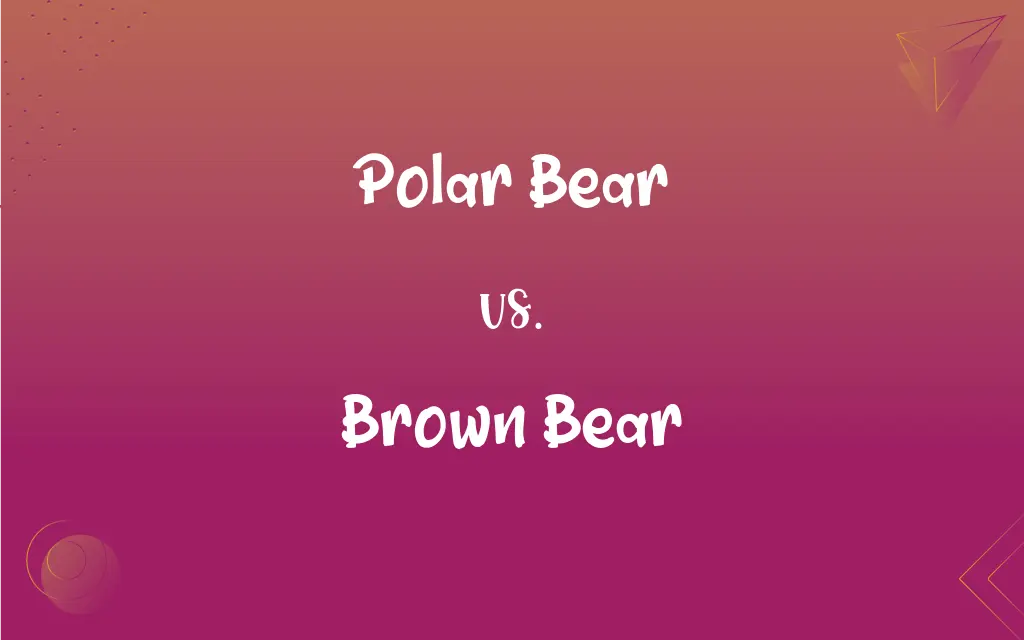Polar Bear vs. Brown Bear: What's the Difference?
Edited by Aimie Carlson || By Janet White || Published on December 22, 2023
Polar Bear is a large, carnivorous bear adapted to Arctic life with white fur. Brown Bear is a large bear species with varying fur color, found in various habitats including forests.

Key Differences
Polar bears are native to the Arctic region, uniquely adapted to cold climates with their thick, white fur and layer of blubber for insulation. Brown bears, also known as grizzly bears in North America, are found in diverse habitats including forests, mountains, and even coastal areas, and have brownish fur which can vary in shade.
Diet is a major differentiator; polar bears primarily feed on seals and are more carnivorous, relying heavily on marine life. Brown bears have a more varied diet, including fish, mammals, insects, and a significant amount of vegetation, reflecting their adaptation to different environments.
In terms of size, polar bears are generally larger and heavier than brown bears, with adult males often weighing over 1,000 pounds. Brown bears, while still large, are typically smaller than polar bears, with their size varying greatly depending on their geographic location and food availability.
Polar bears are solitary animals, mostly found alone except during mating season or when mothers are with cubs. Brown bears, although also largely solitary, can be seen gathering in large numbers in places like Alaska’s rivers during salmon runs.
Conservation status differs; polar bears are classified as vulnerable due to climate change impacting their Arctic ice habitat, whereas brown bear populations are more stable, though some subspecies are endangered or extinct.
ADVERTISEMENT
Comparison Chart
Habitat
Arctic regions, sea ice
Forests, mountains, coasts
Fur Color
White or ivory
Varies from light brown to dark brown
Diet
Primarily carnivorous (seals, marine life)
Omnivorous (fish, mammals, vegetation)
Size
Larger, heavier
Generally smaller than polar bears
Behavior
Mostly solitary
Solitary but can gather in groups
ADVERTISEMENT
Polar Bear and Brown Bear Definitions
Polar Bear
Polar bears are large carnivorous bears adapted to life in the Arctic.
The polar bear roamed the icy landscape in search of seals.
Brown Bear
Brown bears are large omnivorous bears found in various habitats.
The brown bear foraged in the forest for berries and roots.
Polar Bear
Polar bears have white fur and a thick layer of blubber for insulation.
The polar bear's white fur camouflaged it against the snow.
Brown Bear
Brown bears are generally solitary but can gather in groups seasonally.
Several brown bears congregated near the waterfall during the salmon run.
Polar Bear
Polar bears are skilled swimmers, often traveling long distances in water.
The polar bear swam effortlessly between ice floes.
Brown Bear
Brown bears, known as grizzlies in North America, can be very large.
The imposing brown bear stood tall as it scanned its surroundings.
Polar Bear
Polar bears are vulnerable species due to climate change and melting sea ice.
Conservation efforts are critical for the polar bear's survival.
Brown Bear
Brown bears have a diet that includes fish, mammals, and vegetation.
A brown bear was spotted catching salmon in the river.
Polar Bear
Polar bears are solitary animals except during mating or when females have cubs.
A female polar bear was seen sheltering her cubs in a snow den.
Brown Bear
Brown bears' conservation status varies, with some subspecies being endangered.
The conservation of the brown bear's habitat is essential for its survival.
FAQs
How are polar bears adapted to swimming?
Polar bears are skilled swimmers with partially webbed front paws for long-distance swimming.
Can brown bears be found outside North America?
Yes, brown bears are found in parts of Europe and Asia, besides North America.
Why are polar bears vulnerable to climate change?
Climate change reduces sea ice, impacting their ability to hunt seals.
Do brown bears hibernate?
Brown bears hibernate during winter in colder climates.
How do polar bears hunt for food?
Polar bears hunt by waiting at seal breathing holes or breaking into their dens.
What do brown bears typically eat?
Brown bears have an omnivorous diet, including fish, mammals, and vegetation.
What is the typical size of a brown bear?
The size of brown bears varies, but they can weigh up to 800 pounds or more.
How long do brown bears live?
Brown bears can live 20-30 years in the wild.
What is the primary habitat of a polar bear?
Polar bears primarily live in the Arctic region on sea ice.
What threats do polar bears face?
Main threats include climate change, melting sea ice, and human activities.
Do polar bears have any natural predators?
Adult polar bears have no natural predators, but cubs can be vulnerable.
Are polar bears more carnivorous than brown bears?
Yes, polar bears are more carnivorous, mainly feeding on seals.
What color is a polar bear’s skin?
A polar bear’s skin is black, which helps absorb heat.
Are all brown bears called grizzlies?
Not all; grizzlies are a subspecies of brown bear in North America.
What regions do brown bears inhabit?
Brown bears inhabit North America, Europe, and parts of Asia.
How do polar bears keep warm in Arctic temperatures?
They have thick fur and a layer of blubber for insulation.
Are brown bear populations stable?
Brown bear populations are generally stable, though some subspecies are endangered.
What is the social behavior of brown bears?
Brown bears are mostly solitary but can gather in groups, especially during salmon runs.
Can polar bears smell seals under the ice?
Yes, polar bears have a strong sense of smell to detect seals under ice.
How fast can a brown bear run?
Brown bears can run up to 30 miles per hour.
About Author
Written by
Janet WhiteJanet White has been an esteemed writer and blogger for Difference Wiki. Holding a Master's degree in Science and Medical Journalism from the prestigious Boston University, she has consistently demonstrated her expertise and passion for her field. When she's not immersed in her work, Janet relishes her time exercising, delving into a good book, and cherishing moments with friends and family.
Edited by
Aimie CarlsonAimie Carlson, holding a master's degree in English literature, is a fervent English language enthusiast. She lends her writing talents to Difference Wiki, a prominent website that specializes in comparisons, offering readers insightful analyses that both captivate and inform.






































































